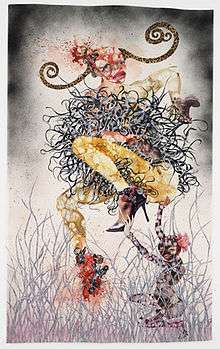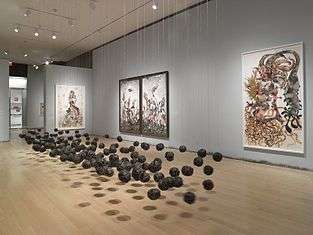Wangechi Mutu

| Wangechi Mutu | |
|---|---|
| Born |
22 June 1972 Nairobi, Kenya |
Wangechi Mutu (born 22 June 1972 in Nairobi, Kenya) is an artist and sculptor who lives and works in Brooklyn, New York. Mutu is considered by many to be one of the most important contemporary African artists of recent years, and her work has achieved much global acclaim.[1]
Background and education
Originally from Kenya, Mutu was educated in Nairobi at Loreto Convent Msongari (1978–1989) and later studied at the United World College of the Atlantic, Wales (I.B., 1991). Mutu moved to New York in the 1990s, focusing on Fine Arts and Anthropology at The New School for Social Research and Parsons School of Art and Design. She earned a BFA from Cooper Union for the Advancement of the Arts and Science in 1996, and then received a master's degree in sculpture from Yale University in 2000.[2]
Career

Mutu's work has been exhibited at galleries and museums worldwide including the San Francisco Museum of Modern Art, the Miami Art Museum, Tate Modern in London, the Studio Museum in Harlem in New York, Museum Kunstpalast in Düsseldorf, Germany the Centre Georges Pompidou in Paris, the Nasher Museum of Art at Duke University. Her first solo exhibition at a major North American museum opened at the Art Gallery of Ontario in March 2010.[3] Her first U.S. solo exhibition, Wangechi Mutu: A Fantastic Journey[4] in the United States opened at Nasher Museum of Art on 21 March 2013. A Fantastic Journey subsequently traveled to the Brooklyn Museum's Elizabeth A. Sackler Center for Feminist Art in October 2013.[5] She has held recent one-person shows at the Museum of Contemporary Art Australia; Deutsche Guggenheim, Berlin; the Brooklyn Museum of Art; Montreal Museum of Contemporary Art; San Francisco Museum of Modern Art; Staatlichen Kunsthalle Baden-Baden, Germany; Wiels Contemporary Art Center, Brussels; the Nasher Museum of Art at Duke University, North Carolina; the Block Museum of Art at Northwestern University, Illinois; and Miami Art Museum.
"Art allows you to imbue the truth with a sort of magic... so it can infiltrate the psyches of more people, including those who don't believe the same things as you." - Wangechi Mutu
She participated in the 2008 Prospect 1 Biennial in New Orleans and the 2004 Gwangju Biennale in South Korea. Her work has been featured in major exhibitions including Greater New York at the P.S.1 Contemporary Art Center and the Museum of Modern Art in New York, Black President: The Art and Legacy of Fela Anikulapo-Kuti at the New Museum of Contemporary Art in New York and the Barbican Centre in London, and USA Today at the Royal Academy in London.
On 23 February 2010, Wangechi Mutu was honoured by Deutsche Bank as their first "Artist of the Year". The prize included a solo exhibition at the Deutsche Guggenheim in Berlin. Titled My Dirty Little Heaven, the show travelled in June 2010 to the Wiels Center for Contemporary Art in Forest, Belgium.
She is represented by Barbara Gladstone in New York, Susanne Vielmetter Los Angeles Projects in Los Angeles and Victoria Miro Gallery in London.

In Fall 2013, the creative team of Wangechi Mutu took part in the main project of the 5th Moscow Biennale of Contemporary Art.[6]
In 2013, Mutu was awarded the BlackStar Film Festival Audience Award for Favorite Experimental Film in Philadelphia, PA and the Brooklyn Museum Artist of the Year, Brooklyn, NY.[7]
In 2014 she participated in 'The Divine Comedy. Heaven, hell, purgatory from the perspective of African contemporary artists' Museum of Modern Art (MMK), Frankfurt / Main, curated by Simon Njami. Wangechi Mutu was awarded the 2014 United States Artist Grant.
In 2015, Wangechi Mutu participated in the The 56th Venice Biennale's International Art Exhibition titled "All The World's Futures", curated by Okwui Enwezor at the Giardini and the Arsenale venues. She also participated in the Dak'Art Biennial, the Kochi-Muziris Biennial, the Paris Triennial: Intense Proximity, the International Center of Photography's Triennial, and the Moscow Biennale.
Her work is included in the collections of the Museum of Modern Art, New York; The Whitney Museum of American Art; The Studio Museum in Harlem; The Museum of Contemporary Art, Chicago; the Museum of Contemporary Art, Los Angeles; the Nasher Museum of Art at Duke University; the Montreal Museum of Contemporary Art; the Brooklyn Museum; and Tate Modern in London.
Works
Wangechi Mutu's work crosses a variety of mediums, including collage, video, performance, and sculpture, and investigates themes of gender, race, and colonialism.[2] At the center of it she often places a performing or posed figure and uses this as a means to focus the eye and to unlock dialogue about perception in both personal and political realms. She's primarily interested in how identity pivots around a kind of social contract that can only be broken through personal and political re-invention and a re-writing of the codes that have been used to represent us. Her work proposes the need for a multiple-consciousness and an awareness of identity as performance to be able to remake the rules that bind our imagination. In order to reorganize the reality that serves us unsavory images of ourselves, Mutu creatively dismantles old tropes and intricately pieces together new ones. Through performance, collage-paintings, video, and sculpture, she continues to think about the complications of being and how one's physical body plays such a huge role in determining their experiences, survival, and ability to understand what that is. Her characters have the appearance of cyborgs or hybrid-species, often altered and enhanced, while positioned to imply power, unknowableness, and inherently vulnerable femaleness. In their very creation is a questioning of the role each and every one of us plays in our self-determination, in the well being of other humans, and the awareness of multiple cultural perspectives and the health of our ailing planet. Mutu has been experimenting with animation, painting on new surfaces, infusing the space with visceral environmental elements, and implementing the same rigor and commitment to bolder, more complex representations of the African subject and to a deeper investment in subjects typically relegated to the borders, margins, and silent spots of our shared history.

More recently, Mutu has exhibited sculptural installations.[8] In 2006, Mutu and British architect David Adjaye collaborated on a project. They transformed the Upper East Side Salon 94 townhouse in New York into a subterraneous dinner party-setting titled Exhuming Gluttony: A Lover’s Requiem. Furs and bullet holes adorned the walls while wine bottles dangled in a careless chandelier-like form above the stained table. The table’s multiple legs resembled thick femurs with visibly delicate tibias, and the whole space had a pungent aroma. The artists strove to show a moment of gluttony. This vicious hunger was seen as a connection between images of The Last Supper, the climate of the current art-buying world, and the war in Iraq.[1]
Another installation of Mutu, Suspended Playtime (2008) is a series of bundles of garbage bags, wrapped in gold twine as if suspended in spiders' webs, all suspended from the ceiling over the viewer. The installation makes reference to the common use of garbage bags as improvised balls and other playthings by African children.
In 2013, Wangechi Mutu's first-ever animated video, The End of Eating Everything,[9] was created in collaboration with recording artist Santigold, commissioned by the Nasher Museum of Art. The video was animated by Awesome + Modest.[10]
In 2014, Mutu's art was on display at an exhibition entitled Nguva na Nyoka, at Victoria Miro Gallery in London. At the exhibition's opening night, Mutu displayed a performance piece, wherein guests were encouraged to consume custom-made Wangechi Mutu chocolate mermaids. The guests could obtain a mermaid only by "snapping a photo of their first bite, lick, taste," operating as a commentary on "the public consumption of brown bodies."[11]
Afrofuturism Influence

Mutu's work has been called "firmly Afrofuturist," [12] as exemplified in her piece, The End of Eating Everything.[9] In her 2013-2014 installation at the Brooklyn Museum, the curatorial placard accompanying her work A'gave, described Afrofuturism as "an aesthetic that uses the imaginative strategies of science fiction to envision alternate realities for Africa and people of African descent." [13] For critics, Mutu's imagined alternate realities for Africa through the medium of science fiction definitively situated Mutu in the genre of Afrofuturism.
Specific elements of Mutu's art that situate her within this genre include her amalgamation of human and machine, a Cyborg, within her material works, such as Family Tree[14] as well as in The End of Eating Everything. Additionally, Mutu's work consistently involves intentional re-imagination of the African experience. In Misguided Little Unforgivable Hierarchies, she examines social hierarchy and power relationships through the medium of collage, for "rankings of peoples have historically been constructed around fabricated racial and ethnic categories." [15] In Family Tree, as in many of her works, Mutu deliberately constructs both a past and a future within the single figure through displaying diagrams from antique medical journals as well as mechanical images.[14]
References
- 1 2 Enwezor, Okwui (February 2011). "Cut & Paste". Arise Magazine. Retrieved 13 April 2013.
- 1 2 Posner, Helaine (2013). "Bad Girls: Wangechi Mutu". In Heartney, Eleanor. The Reckoning: Women Artists of the New Millennium. New York: Prestel. pp. 54–59. ISBN 978-3-7913-4759-2.
- ↑ Provocative Artist Wangechi Mutu to Tear Up Gallery Walls in Canadian Debut, AGO press release, 2 February 2010
- ↑ "Wangechi Mutu: A Fantastic Journey". Nasher.duke.edu. Retrieved 24 September 2013.
- ↑ "Wangechi Mutu: A Fantastic Journey". Brooklyn Museum. Retrieved 26 February 2015.
- ↑ "В основном проекте 5-й Московской биеннале примут участие 72 художника и творческих коллектива | Art | Новости". Artaktivist.org. Retrieved 24 September 2013.
- ↑ Mutu, Wangechi. "History". Wangechi Mutu. Retrieved 11 December 2014.
- ↑ Evans, Matthew. "An encounter with Wangechi Mutu". Deutsche Bank. Retrieved 13 April 2013.
- 1 2 "Wangechi Mutu + Santigold – The End of eating Everything – Nasher Museum at Duke". YouTube. 21 July 2013. Retrieved 24 September 2013.
- ↑ "Awesome + Modest website".
- ↑ Mutu, Wangechi. "News". Wangechi Mutu. Retrieved 11 December 2014.
- ↑ Kaitano, Chiwoniso (13 Nov 2013). "The Afrofuturism of Wangechi Mutu". The Guardian. Retrieved 11 December 2014.
- ↑ Byrne, Brendan. "Cyborg Humanism: Wangechi Mutu at Brooklyn Museum". Rhizome. Retrieved 11 December 2014.
- 1 2 Mutu, Wangechi. "Family Tree". Brooklyn Museum. Brooklyn Museum. Retrieved 11 December 2014.
- ↑ Mutu, Wangechi. "Misguided Little Unforgivable Hierarchies". Brooklyn Museum. Brooklyn Museum. Retrieved 11 December 2014.
Further reading
- Wangechi Mutu, as told to Faye Hirsch. "The Women". Art in America, November 2013. New York: Brant Publications, Inc. pp. 54–55.
- "Grotesque Sensations: Carnivalising the Sensorium in the Art of Wangeshi Mutu" by Bettina Papenburg in: B. Papenburg and M. Zarzycka (eds.) Carnal Aesthetics. London: I.B.Tauris, 2013. ISBN 978-1-78076-013-1.
External links
- Wangechi Mutu Studio, New York
- Wangechi Mutu at the Deutsche Guggenheim, Berlin